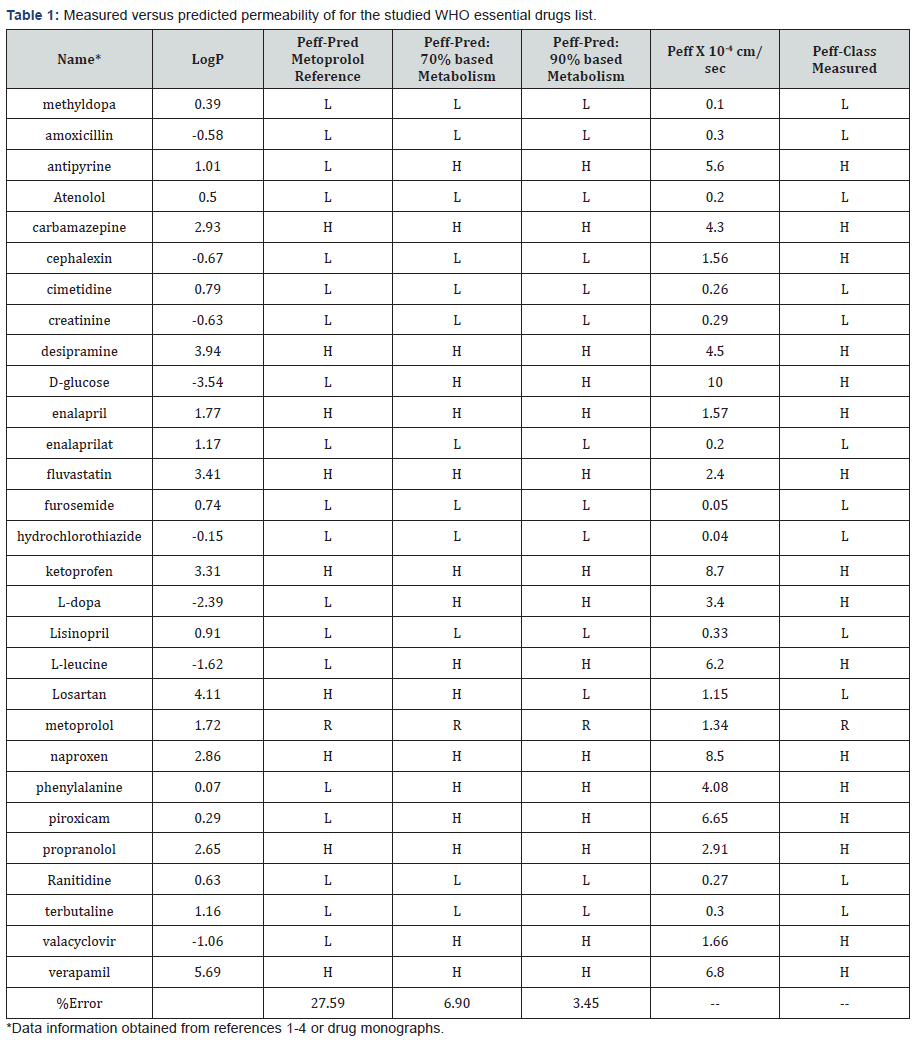The Use of Metabolism Versus Partition Coefficient in Predicting Human Intestinal Permeability Classification-Juniper Publishers
JUNIPER PUBLISHERS-OPEN ACCESS JOURNAL OF DRUG DESIGNING & DEVELOPMENT
Abstract
Aim: The aim of this review commentary is to compare measured permeability class versus predicted one using metabolism and partition coefficient values for WHO essential drugs list.
Methods: Predicted permeability classes were based on partition coefficient or metabolism. Comparisons were then done against measured permeability classes.
Results and discussion: Predictions were close to measured permeability classes for many drugs using all prediction methods using metoprolol coefficients as reference marker and high extraction ratio for high permeability. However, some false negative and false positive predictions were observed. This can lead to wrong permeability classification and hence wrong biopharmaceutics classification (BCS). The best method with least false predictions in the studied compounds was using more than 90% metabolism as indicator of high permeability, Hence it is suggested to be used for better permeability classification prediction.
Keywords: Metabolism; Permeability; Partition coefficient; BCS; BDDCS
Background
Biopharmaceutics classification system (BCS) has classified drugs into four classes based on permeability and solubility [1]. BCS has become a corner stone in waiver of bioequivalence studies of generic drug products. Solubility class is usually easy to figure out, but permeability is not. Over the last 10 years, some trials were done to help predict human permeability class using drug partition coefficient and drug metabolism. However, limitations were observed due to existence of false positive and false negative predictions. Moreover, some differences were observed between BCS and the proposed biopharmaceutics drug disposition classification system (BDDCS) that has classified drugs into four classes based on metabolism and solubility [2-4]. US FDA has issued guideline for waiver of classes I and III drugs with support of permeability and solubility classes [5]. With this dilemma in mind, one needs a good way to predict correct permeability class and hence correct BCS class I or III.
Objectives
The aim of this review commentary is to compare measured permeability class versus predicted one using metabolism,diffusion and partition coefficient values for WHO essential drugs list.
Methods
Predicted permeability classes for 29 compounds from WHO essential drugs list were based on partition coefficient or metabolism. Metoprolol partition coefficient was used as reference marker compound. Hence, all values above metoprolol are classified as high permeability classes. However, high extraction ratio drugs with more than 70% metabolism are classified as high permeability classes. Then, drugs with more than 90% metabolism are classified as high permeability classes. Comparisons were then done against measured permeability classes to investigate the best method of prediction. Percent prediction error was calculated using the equation:
% Error = (number of wrong predictions / total number) X 100
Results and Discussion
Predictions were close to measured permeability classes for many drugs using all prediction methods using metoprolol as reference marker and high extraction ratio for high permeability. However, some false negative and false positive predictions were observed as shown in (Table 1). 8 drugs showed false predictions with 27.5% prediction error when using partition coefficient alone. This can lead to wrong permeability classification and hence wrong biopharmaceutics classification (BCS). On the other hand, only 2 drugs showed false predictions with 6.9 % prediction error when using more than 70% metabolism as cutoff of high permeability, while only 1 drug showed false predictions with 3.5% prediction error when using more than 90% metabolism as cutoff of high permeability. The best method with least false predictions in the studied compounds was using more than 90% metabolism as indicator of high permeability.

Conclusion
It is suggested to use more than 90% metabolism as cut off value to predict high permeability when trying to classify drug permeability classification.
For more Open Access Journals in Juniper Publishers please click on: https://juniperpublishers.com
For more articles in Open Access Novel Approaches in Drug Designing & Development please click on: https://juniperpublishers.com/napdd/index.php
For more Open Access Journals please click on: https://juniperpublishers.com
To know more about Juniper Publishers please click on: https://juniperpublishers.business.site/




Comments
Post a Comment